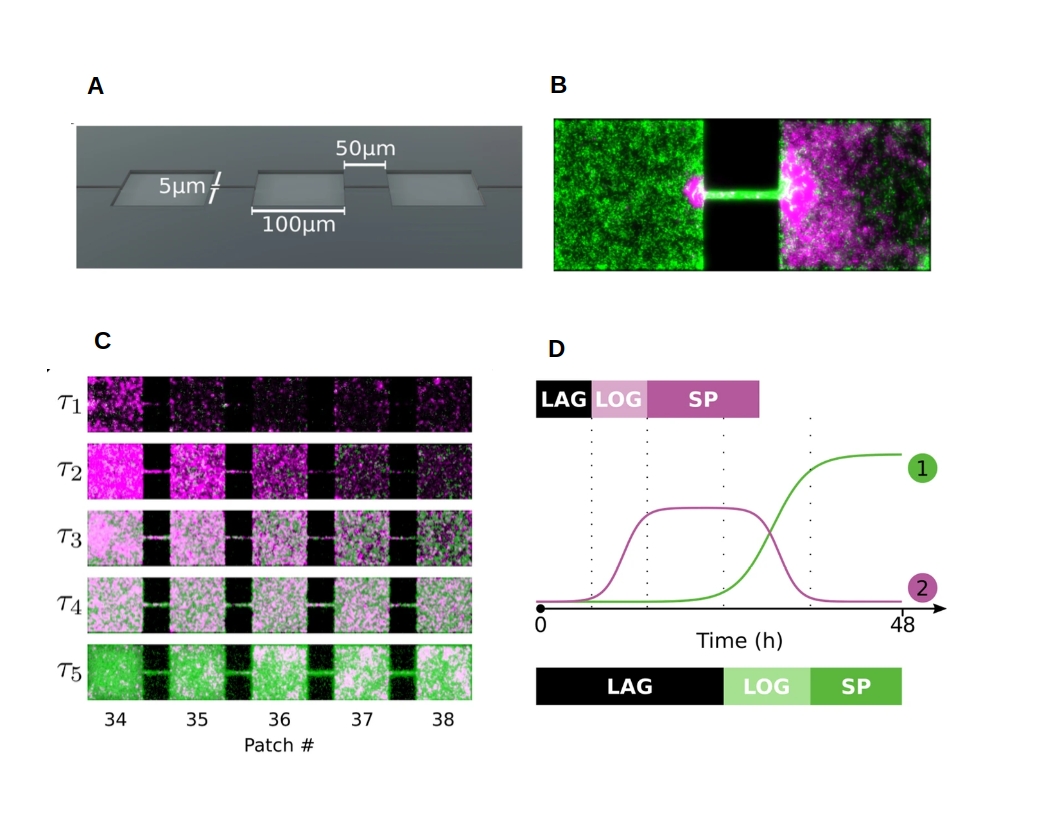|
Competition–colonization Trade-off
In ecology, the competition–colonization trade-off is a stabilizing mechanism that has been proposed to explain species diversity in some biological systems, especially those that are not in equilibrium. In which case some species are particularly good at colonizing and others have well-established survival abilities. The concept of the competition-colonization trade-off was originally proposed by Levins and Culver, the model indicated that two species could coexist if one had impeccable competition skill and the other was excellent at colonizing. The model indicates that there is typically a trade-off, in which a species is typically better at either competing or colonizing. A later model, labelled The Lottery Model was also proposed, in which interspecific competition is accounted for within the population. Mathematical models Levins and Culver model : \frac = c_1 p_1 (1 - p_1) - m_1 p_1 : \frac = c_2 p_2 (1 - p_1 - p_2) - m_2 p_2 - c_1 p_1 p_2 Where: p_i = fractio ... [...More Info...] [...Related Items...] OR: [Wikipedia] [Google] [Baidu] |
Ecology
Ecology () is the natural science of the relationships among living organisms and their Natural environment, environment. Ecology considers organisms at the individual, population, community (ecology), community, ecosystem, and biosphere levels. Ecology overlaps with the closely related sciences of biogeography, evolutionary biology, genetics, ethology, and natural history. Ecology is a branch of biology, and is the study of abundance (ecology), abundance, biomass (ecology), biomass, and distribution of organisms in the context of the environment. It encompasses life processes, interactions, and adaptations; movement of materials and energy through living communities; ecological succession, successional development of ecosystems; cooperation, competition, and predation within and between species; and patterns of biodiversity and its effect on ecosystem processes. Ecology has practical applications in fields such as conservation biology, wetland management, natural resource m ... [...More Info...] [...Related Items...] OR: [Wikipedia] [Google] [Baidu] |
Coexistence Theory
Coexistence theory is a framework to understand how competitor traits can maintain species diversity and stave-off competitive exclusion even among similar species living in ecologically similar environments. Coexistence theory explains the stable coexistence of species as an interaction between two opposing forces: fitness differences between species, which should drive the best-adapted species to exclude others within a particular ecological niche, and stabilizing mechanisms, which maintains diversity via niche differentiation. For many species to be stabilized in a community, population growth must be negative density-dependent, i.e. all participating species have a tendency to increase in density as their populations decline. In such communities, any species that becomes rare will experience positive growth, pushing its population to recover and making local extinction unlikely. As the population of one species declines, individuals of that species tend to compete predomi ... [...More Info...] [...Related Items...] OR: [Wikipedia] [Google] [Baidu] |
Species Diversity
Species diversity is the number of different species that are represented in a given community (a dataset). The effective number of species refers to the number of equally abundant species needed to obtain the same mean proportional species abundance as that observed in the dataset of interest (where all species may not be equally abundant). Meanings of species diversity may include species richness, taxonomic or phylogenetic diversity, and/or species evenness. Species richness is a simple count of species. Taxonomic or phylogenetic diversity is the genetic relationship between different groups of species. Species evenness quantifies how equal the abundances of the species are.Hill, M. O. (1973) Diversity and evenness: a unifying notation and its consequences. Ecology, 54, 427–432Tuomisto, H. (2010) A diversity of beta diversities: straightening up a concept gone awry. Part 1. Defining beta diversity as a function of alpha and gamma diversity. Ecography, 33, 2-22. Tuomisto, H. 2 ... [...More Info...] [...Related Items...] OR: [Wikipedia] [Google] [Baidu] |
Intertidal Zone
The intertidal zone or foreshore is the area above water level at low tide and underwater at high tide; in other words, it is the part of the littoral zone within the tidal range. This area can include several types of habitats with various species of life, such as sea stars, sea urchins, and many species of coral with regional differences in biodiversity. Sometimes it is referred to as the ''littoral zone'' or '' seashore'', although those can be defined as a wider region. The intertidal zone also includes steep rocky cliffs, sandy beaches, bogs or wetlands (e.g., vast mudflats). This area can be a narrow strip, such as in Pacific islands that have only a narrow tidal range, or can include many meters of shoreline where shallow beach slopes interact with high tidal excursion. The peritidal zone is similar but somewhat wider, extending from above the highest tide level to below the lowest. Organisms in the intertidal zone are well-adapted to their environment, facing high ... [...More Info...] [...Related Items...] OR: [Wikipedia] [Google] [Baidu] |
Southern California
Southern California (commonly shortened to SoCal) is a geographic and Cultural area, cultural List of regions of California, region that generally comprises the southern portion of the U.S. state of California. Its densely populated coastal region includes Greater Los Angeles (the second-most populous urban agglomeration in the United States) and San Diego County (the second-most populous county in California). The region generally contains ten of California's 58 counties: Los Angeles County, California, Los Angeles, San Diego County, California, San Diego, Orange County, California, Orange, Riverside County, California, Riverside, San Bernardino County, California, San Bernardino, Kern County, California, Kern, Ventura County, California, Ventura, Santa Barbara County, California, Santa Barbara, San Luis Obispo County, California, San Luis Obispo, and Imperial County, California, Imperial counties. Although geographically smaller than Northern California in land area, Southern ... [...More Info...] [...Related Items...] OR: [Wikipedia] [Google] [Baidu] |
Green Algae
The green algae (: green alga) are a group of chlorophyll-containing autotrophic eukaryotes consisting of the phylum Prasinodermophyta and its unnamed sister group that contains the Chlorophyta and Charophyta/ Streptophyta. The land plants ( Embryophytes) have emerged deep within the charophytes as a sister of the Zygnematophyceae. Since the realization that the Embryophytes emerged within the green algae, some authors are starting to include them. The completed clade that includes both green algae and embryophytes is monophyletic and is referred to as the clade Viridiplantae and as the kingdom Plantae. The green algae include unicellular and colonial flagellates, most with two flagella per cell, as well as various colonial, coccoid (spherical), and filamentous forms, and macroscopic, multicellular seaweeds. There are about 22,000 species of green algae, many of which live most of their lives as single cells, while other species form coenobia (colonies), long filaments ... [...More Info...] [...Related Items...] OR: [Wikipedia] [Google] [Baidu] |
Barnacle
Barnacles are arthropods of the subclass (taxonomy), subclass Cirripedia in the subphylum Crustacean, Crustacea. They are related to crabs and lobsters, with similar Nauplius (larva), nauplius larvae. Barnacles are exclusively marine invertebrates; many species live in shallow and tidal waters. Some 2,100 species have been described. Barnacle adults are Sessility (motility), sessile; most are Filter feeder, suspension feeders with hard calcareous shells, but the Rhizocephala are parasitic castration, specialized parasites of other crustaceans, with reduced bodies. Barnacles have existed since at least the mid-Carboniferous, some 325 million years ago. In folklore, barnacle geese were once held to emerge fully formed from goose barnacles. Both goose barnacles and the Austromegabalanus psittacus, Chilean giant barnacle are fished and eaten. Barnacles are economically significant as biofouling on ships, where they cause hydrodynamic Drag (physics), drag, reducing efficiency. Ety ... [...More Info...] [...Related Items...] OR: [Wikipedia] [Google] [Baidu] |
Red Algae
Red algae, or Rhodophyta (, ; ), make up one of the oldest groups of eukaryotic algae. The Rhodophyta comprises one of the largest Phylum, phyla of algae, containing over 7,000 recognized species within over 900 Genus, genera amidst ongoing taxonomic revisions. The majority of species (6,793) are Florideophyceae, and mostly consist of multicellular, ocean, marine algae, including many notable seaweeds. Red algae are abundant in marine habitats. Approximately 5% of red algae species occur in freshwater environments, with greater concentrations in warmer areas. Except for two coastal cave dwelling species in the asexual class Cyanidiophyceae, no terrestrial species exist, which may be due to an evolutionary bottleneck in which the last common ancestor lost about 25% of its core genes and much of its evolutionary plasticity. Red algae form a distinct group characterized by eukaryotic cells without flagella and centrioles, chloroplasts without external endoplasmic reticulum or unstack ... [...More Info...] [...Related Items...] OR: [Wikipedia] [Google] [Baidu] |
Metacommunity
An ecological metacommunity is a set of interacting communities which are linked by the dispersal of multiple, potentially interacting species. The term is derived from the field of community ecology, which is primarily concerned with patterns of species distribution, abundance and interactions. Metacommunity ecology combines the importance of local factors (environmental conditions, competition, predation) and regional factors (dispersal of individuals, immigration, emigration) to explain patterns of species distributions that happen in different spatial scales. There are four theoretical frameworks, or unifying themes, that each detail specific mechanistic processes useful for predicting empirical community patterns. These are the patch dynamics, species sorting, source–sink dynamics (or mass effect) and neutral model frameworks. Patch dynamics models describe species composition among multiple, identical patches, such as islands. In this framework, species are able to ... [...More Info...] [...Related Items...] OR: [Wikipedia] [Google] [Baidu] |
Ecological Succession
Ecological succession is the process of how species compositions change in an Community (ecology), ecological community over time. The two main categories of ecological succession are primary succession and secondary succession. Primary succession occurs after the initial Colonisation (biology), colonization of a newly created habitat with no living organisms. Secondary succession occurs after a Disturbance (ecology), disturbance such as fire, habitat destruction, or a natural disaster destroys a pre-existing community. Both consistent patterns and variability are observed in ecological succession. Theories of ecological succession identify different factors that help explain why plant communities change the way they do. Succession was among the first theories advanced in ecology. Ecological succession was first documented in the Indiana Dunes of Northwest Indiana by Henry Chandler Cowles during the late 19th century and remains a main Ecology, ecological topic of study. Over ti ... [...More Info...] [...Related Items...] OR: [Wikipedia] [Google] [Baidu] |
Scramble Competition
In ecology, scramble competition (or complete symmetric competition or exploitation competition) refers to a situation in which a resource is accessible to all competitors (that is, it is not monopolizable by an individual or group). However, since the particular resource is usually finite, scramble competition may lead to decreased survival rates for all competitors if the resource is used to its carrying capacity. Scramble competition is also defined as " finite resource hatis shared equally amongst the competitors so that the quantity of food per individual declines with increasing population density".Den Berg, V., Rossing, W., and Grasman, J. (2006). "Contest and Scramble Competition and the Carry-Over Effect in Globodera spp. In Potato-Based Crop Rotations Using an Extended Ricker Model". Journal of Nematology, 38(2):210-220. A further description of scramble competition is "competition for a resource that is inadequate for the needs of all, but which is partitioned equally a ... [...More Info...] [...Related Items...] OR: [Wikipedia] [Google] [Baidu] |






